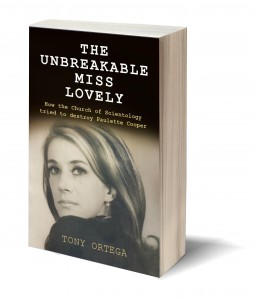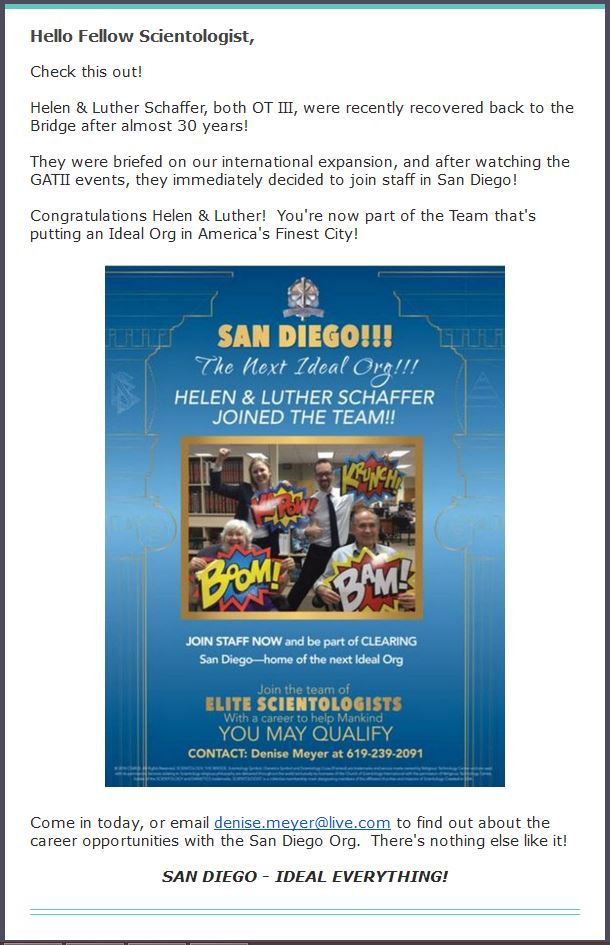 Jon Atack is the author of A Piece of Blue Sky, one of the very best books on L. Ron Hubbard and Scientology. He has a new edition of the book for sale, and for more than three years he’s been helping us sift through the legends, myths, and contested facts about Scientology that tend to get hashed and rehashed in books, articles, and especially on the Internet.
Jon Atack is the author of A Piece of Blue Sky, one of the very best books on L. Ron Hubbard and Scientology. He has a new edition of the book for sale, and for more than three years he’s been helping us sift through the legends, myths, and contested facts about Scientology that tend to get hashed and rehashed in books, articles, and especially on the Internet.
To be a true Scientologist, it is necessary to submit to various phobias. It has long fascinated me that certain topics are simply beyond discussion.
As a teenager, I was taken by a friend to a Christadelphian meeting, where the whole audience joined in mirth at the idea that we might be related to primates. It was the same sort of knee-jerk humour that Scientologists show whenever psychiatry is mentioned. No thinking is required.
I happened to have met a few psychiatrists before joining Scientology, and for the most part, I agreed with the condemnation of that profession, because with one exception the psychiatrists I had met were haughty and authoritarian. I was not at all impressed with the routine use of electroconvulsive therapy (ECT) either, so needed no urging to join Scientology’s campaign against it.
Robert Jay Lifton’s remarkable model of thought reform includes “ideology over experience” or “doctrine over person.” This is where the dogma of the group is accepted even when it contradicts personal experience.
For instance, if the cult says that cigarettes are good for you, you have to put aside your beloved uncle’s struggle with emphysema and toe the party line. Hubbard said people smoke to imitate volcanoes. As a 100-a-day man, he had significant volcano problems, and was bedridden every winter with bronchial problems that both the Clearing Course and OT III attempted to cure. David Miscavige has still failed to quit, although, like Hubbard he suffers from asthma (inhaler in one hand, cigarette in the other, is the image I have).
In line with Lifton’s observation: The cult’s doctrine is true, even if your own perception disagrees. Its ideology is more true than your experience.
I was willing to accept that ECT and psychosurgery were wrong, but I had been befriended by a psychiatrist as a thirteen-year-old and known her for five years by the time I wandered into Scientology.
She opposed the use of drugs and psychosurgery. She felt that ECT was over-used. So, I never managed to adopt the party line – that all psychiatrists throughout the universe are part of a conspiracy to destroy humanity. Hubbard also added all other professions with the prefix “psych” – so psychotherapists and psychologists are all locked in this immense conspiracy.
This spurious belief takes no account of the reality (unless you believe that “reality is agreement,” of course): put any two “psychs” in a room together and you will quickly have a disagreement; these people are not joiners. The hundreds of differing schools of psychotherapy prove this point rather easily. Conspirators have to agree, and the “psychs” evidently do not. But Scientologists titter on cue when listening to Hubbard’s ceaseless psych-bashing.
To resolve any doubt, Hubbard even thanked psychiatrist William Alanson White in the acknowledgments of Science of Survival: ‘Acknowledgement is made to fifty-thousand years of thinking men without whose speculations and observations the creation and construction of Dianetics would not have been possible. Credit in particular is due to…’
Psychotherapists Sigmund Freud and Commander Thompson are also on the list, as is “alienist” (i.e. psychiatrist) and hypnotist Jean-Martin Charcot, and psychologist William James. Scientology could not have existed without these “psych” pioneers who were nonetheless part of a conspiracy to ensure that Scientology would not exist.
The “psychs” are far from the only phobia induced by Hubbard in his followers. Although he clearly stated that he had practised hypnosis intensively for almost 25 years before founding Dianetics, the subject is taboo (he also said: “Never believe a hypnotist”).
Hubbard said, “A lot of people are in a more or less hypnotic daze,” and that Scientology would release us all from that daze, yet we learned precisely nothing about hypnosis. Or rather, we learned a great deal about it, by being constantly subjected to it, but the topic itself is almost never mentioned.
Hubbard even asserted that it is not possible to “audit” well without understanding hypnosis (I would agree that no one should attempt counseling without such an understanding). But I have yet to meet a Scientologist who has such an understanding.
Hubbard was unequivocal on the subject: The auditor “must be prepared to use hypnotism, he must know how it works, what he should do to make it function, how to regress a person in hypnotism and so on…” By these criteria, there are no properly trained auditors in Scientology.
Instead, Scientologists share the general public fear of hypnosis, which is based in the mistaken notion that hypnosis is done to you, rather than the understanding that we have hypnotic abilities as a part of our mental capacities. If we control those abilities, they are useful, if someone outside controls them, then we are ourselves controlled.
The unwillingness to consider evidence is the fundamental trap of any totalist group. The leader says that the earth is flat and the moon is made of cheese.
Contradiction is impossible: The earth is flat, the moon is made of cheese, the Fourth Invader Force lives in the boiling heat of Venus, we are the descendants of clams, and Ron Hubbard is the first person to make any valid contribution to the fields of mind and spirit in 50,000 years (his gratitude to White, et al., did not last).
Scientology is not alone in offering complete “self-determinism” by surrendering the right to consider evidence or make any decisions. In her excellent book, Bounded Choice, Professor Janja Lalich (not a “psych” but a sociologist, if your phobia is beginning to twitch) speaks of her time in the Democratic Workers Party and the notion of “unity,” which pretty much adds up to doing as you are told.
As the DWP’s guru, Marlene Dixon, put it: “Unity of will is the substance and harnesses us together … demanding the surrender of individualism into the greater social whole.” So it is that all Scientologists ultimately join Hubbard’s personal cluster.
Curiously, the phobia of hypnosis is a key to Scientology’s erosion of individuality. This is not to say that the manuals on hypnosis are inevitably true. The field is beset with frauds and charlatans. We have much to discover about this aspect of our behaviour.
However, there can be no doubt that Hubbard’s “reactive mind” was an attempt to define the hypnotic aspects of human response – an unthinking, automatic mind below the level of conscious decision.
In the last couple of decades, the “psychs” have pioneered the “new unconscious,” showing that the Dr Jekyll and Mr Hyde notions of Freud are simplistic and wrong. The unconscious mind is not a vicious beast driven by ignorance and lust.
Freud’s id (and Hubbard’s genetic entity) have disappeared from the picture. Almost all of our responses are automatic, and rather than simply saving us from a fire if unconscious, our behaviour from moment to moment is generally unthinking.
By comparison, the conscious mind has a span of three seconds or less and can include no more than seven chunks of information, each the equivalent of three digits. In my most recent book, Opening Minds, I compare the conscious mind to a pebble on top of the unconscious Everest, and that is about the scale of it.
In a recent interview in New Scientist, Laurence Sugarman gave this useful description: “Hypnosis is simply a skill set for influencing people. It involves facial expression, language, body movement, tone of voice, intensity, metaphor, understanding how people interpret and represent things. It isn’t something you’re in, or that you do: Hypnosis is something that you use. That means its not a therapy; it’s a means to therapy.”
Asked about “trance,” Sugarman continued: “Trance is a process of intense learning. It happens when we change our minds in significant ways, when we become neuroplastic [with the development of new neural pathways]; we are thoughtful, we pause, we change our breathing. There is a shift in the parasympathetic part of the autonomic nervous system – an intensified focus of attention and narrowed peripheral awareness. Trance happens when we are traumatised, and when we fall in love. There’s no such thing as ‘hypnotic trance’ as distinct from the trance of yoga or of prayer, for example. But part of the skill set of hypnosis is recognising and facilitating trance, because it makes whatever you’re learning more effective.” (New Scientist, 12 March 2016).
My significant concern is the inhibition and prevention of thought through phobia induction. Hubbard said, “In learning, study what you want to know, think what you want to think about it, recognize institutionalism for the bogus straw man it is, and keep the analyzer whirring.” And the Church of Scientology is most certainly institutionalised.
Despite all of his pronouncements about self-determinism and freedom of thought (“keep the analyzer whirring”), Hubbard actually induced phobias about communication that echo the information control of the Catholic Church’s index of prohibited books or the book-burning of the Nazis.
True self-determinism includes freedom to “think freely, to talk freely, to write freely their own opinions and to counter and utter or write upon the opinions of others” as the Creed of the Church of Scientology says. Yet, if you try to exercise these privileges in Scientology, you will be sent to Ethics in a heartbeat.
Freedom of thought also includes the determination to understand opposing views. To do this, it is necessary to consider those views, rather than simply dismissing them out of hand.
It is never enough to simply adopt an opinion because it has been expressed by an authority figure: We should only adopt opinions that we understand and that are consistent with our experience of the world.
Let me end with a quotation from one of the most important texts in human history, John Stuart Mill’s On Liberty: “The fatal tendency of mankind to leave off thinking about a thing when it is no longer doubtful is the cause of half their errors. A contemporary author has well spoken of ‘the deep slumber of a decided opinion’.”
Liberty is, above all else, the liberty to make up our own minds. Submission to dogma is abandonment of liberty.
— Jon Atack
——————–
Bonus items from our tipsters
In San Diego: Sometimes, sending those letters to people who haven’t taken a course in decades actually works…
The local reporters are all over it. Would you buy water from this man?
This was recently posted to social media but is actually from last year, winners at the LRH Birthday Event in Clearwater. As is tradition, those are horse racing silks…
——————–
——————–
 Posted by Tony Ortega on May 7, 2016 at 07:00
Posted by Tony Ortega on May 7, 2016 at 07:00
E-mail tips and story ideas to tonyo94 AT gmail DOT com or follow us on Twitter. We post behind-the-scenes updates at our Facebook author page. After every new story we send out an alert to our e-mail list and our FB page.
Our book, The Unbreakable Miss Lovely: How the Church of Scientology tried to destroy Paulette Cooper, is on sale at Amazon in paperback and Kindle editions. We’ve posted photographs of Paulette and scenes from her life at a separate location. Reader Sookie put together a complete index. More information about the book, and our 2015 book tour, can also be found at the book’s dedicated page.
Learn about Scientology with our numerous series with experts…
BLOGGING DIANETICS: We read Scientology’s founding text cover to cover with the help of L.A. attorney and former church member Vance Woodward
UP THE BRIDGE: Claire Headley and Bruce Hines train us as Scientologists
GETTING OUR ETHICS IN: Jefferson Hawkins explains Scientology’s system of justice
SCIENTOLOGY MYTHBUSTING: Historian Jon Atack discusses key Scientology concepts
Other links: Shelly Miscavige, ten years gone | The Lisa McPherson story told in real time | The Cathriona White stories | The Leah Remini ‘Knowledge Reports’ | Hear audio of a Scientology excommunication | Scientology’s little day care of horrors | Whatever happened to Steve Fishman? | Felony charges for Scientology’s drug rehab scam | Why Scientology digs bomb-proof vaults in the desert | PZ Myers reads L. Ron Hubbard’s “A History of Man” | Scientology’s Master Spies | Scientology’s Private Dancer | The mystery of the richest Scientologist and his wayward sons | Scientology’s shocking mistreatment of the mentally ill | Scientology boasts about assistance from Google | The Underground Bunker’s Official Theme Song | The Underground Bunker FAQ
Our Guide to Alex Gibney’s film ‘Going Clear,’ and our pages about its principal figures…
Jason Beghe | Tom DeVocht | Sara Goldberg | Paul Haggis | Mark “Marty” Rathbun | Mike Rinder | Spanky Taylor | Hana Whitfield









